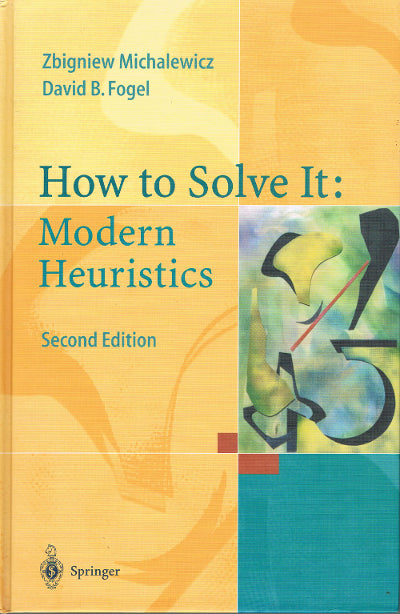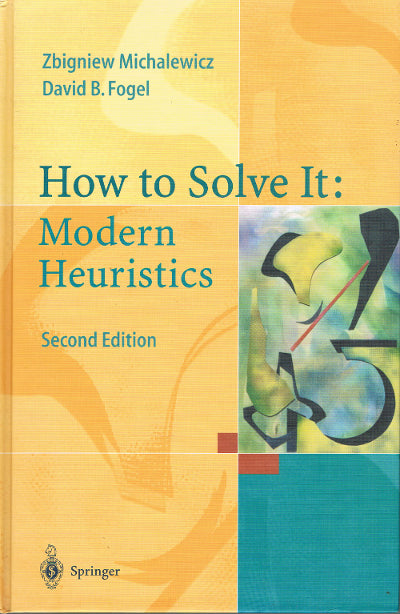How to Solve It: Modern Heuristics, Second Edition (Hardcover)
How to Solve It: Modern Heuristics, Second Edition (Hardcover)
Condition
LIKE NEW: This book is in excellent, like-new condition.
Product Details
From the back cover: "This book is the only source that provides comprehensive, current, and correct information on problem solving using modern heuristics. It covers classic methods of optimization, including dynamic programming, the simplex method, and gradient techniques, as well as recent innovations such as simulated annealing, tabu search, and evolutionary computation. Integrated into the discourse is a series of problems and puzzles to challenge the reader. The book is written in a lively, engaging style and is intended for students and practitioners alike. Anyone who reads and understands the material in the book will be armed with the most powerful problem solving tools currently known.
"This second edition contains two new chapters, one on coevolutionary systems and one on multicriterial decision-making. Also some new puzzles are added and various subchapters are revised."
CONTENTS
The text begins with Prefaces for the Second and First Editions and an Introduction.
I: What are the Ages of My Three Sons?
- Why Are Some Problems Difficult to Solve?
- The size of the search space
- Modeling the problem
- Change over time
- Constraints
- The problem of proving things
- Your chance for glory
- Summary
II: How Important Is a Model?
- Basic Concepts
- Representation
- The objective
- The evaluation function
- Defining a search problem
- Neighborhoods and local optima
- Hill-climbing methods
- Can you sink this trick shot?
- Summary
III: What Are the Prices in 7-11?
- Traditional Methods - Part 1
- Exhaustive search [Enumerating the SAT (Boolean satisfiability problem), TSP (Traveling Salesman Problem), NLP (Natural Language Processing)]
- Local search [Local search and the SAT, TSP, NLP]
- Linear programming: The simplex method
- Summary
IV: What Are the Numbers?
- Traditional Methods - Part 2
- Greedy algorithms [and the SAT, TSP, NLP]
- Divide and conquer
- Dynamic programming
- Branch and bound
- A* algorithm
- Summary
V: What's the Color of the Bear?
- Escaping Local Optima
- Simulated annealing
- Tabu search
- Summary
VI: How Good Is Your Intuition?
- An Evolutionary Approach
- Evolutionary approach for the SAT
- Evolutionary approach for the TSP
- Evolutionary approach for the NLP
- Summary
VII: One of These Things Is Not Like the Others
- Designing Evolutionary Algorithms
- Representation [Fixed-length vectors of symbols, Permutations, Finite state machines, Symbolic expressions]
- Evaluation function
- Variation operators [Fixed-length vectors of symbols, Permutations, Finite state machines, Symbolic expressions]
- Selection
- Initialization
- Summary
VIII: What Is the Shortest Way?
- The Traveling Salesman Problem
- In search of good variation operators
- Incorporating local search methods
- Other possibilities [Edge assembly crossover; Inver-over operator]
- Summary
IX: Who Owns the Zebra
- Constraint-Handling Techniques
- General considerations [Designing evalf; Design of evalu; Relationship between evalf and evalu; Rejecting infeasible solutions; Repairing infeasible individuals; Replacing individuals by their repaired versions; Penalizing infeasible individuals; Maintaining a feasible population using special representations and variation operators; Using decoders; Separating individuals and constraints; Exploring boundaries between feasible and infeasible parts of the search space; Finding feasible solutions]
- Numerical optimization [Methods based on preserving the feasibility of solutions, on penalty functions, on a search for feasible solutions, on decoders; Hybrid methods]
- Summary
X: Can You Tune to the Problem?
- Tuning the Algorithm to the Problem
- Parameter control in evolutionary algorithms
- Illustrating the case with an NLP
- Taxonomy of control techniques
- The possibilities for parameter control [Representation; Evaluation function; Mutation operators and their probabilities; Crossover operators and their probabilities; Parent selection; Population]
- Combining forms of parameter control
- Summary
XI: Can You Mate in Two Moves?
- Time-Varying Environments and Noise
- Life presents a dynamic landscape
- The real world is noisy [Ensuring diversity]
- Modeling of ship trajectory
- Summary
XII: Day of the Week of January 1st
- Neural Networks
- Threshold neurons and linear discriminant functions
- Black propagation for feed forward multilayer perceptions
- Training and testing
- Recurrent networks and extended architectures [Standard recurrent network; Hopfield network; Boltzmann machine; Network of multiple interacting programs]
- Clustering with competitive networks
- Using neural networks to solve the TSP
- Evolving neural networks
- Summary
XII: What Was the Length of the Rope?
- Fuzzy Systems
- Fuzzy sets
- Fuzzy sets and probability measures
- Fuzzy set operations
- Fuzzy relationships
- Designing a fuzzy controller
- Fuzzy clustering
- Fuzzy neural networks
- A fuzzy TSP
- Evolving fuzzy systems
- Summary
XIV: Everything Depends on Something Else
- Coevolutionary Systems
- Playing a game
- Learning to play checkers
- Optimization through competing populations
- Another example with a game
- Artificial life
- Games of cooperation and competition
- Modeling intelligent agents
- Issues in coevolution
- An example of cooperative coevolution on the TSP
- Summary
XV: Who's Taller?
- Multicriteria Decision-Making
- Single numeric approach [The Valuated State Space approach; Fuzzy multicriteria decision-making; Summary]
- Evolutionary multiobjective optimization approach [Brief history; Evolutionary algorithm for multiobjective NLP]
- Summary
XVI: Do You Like Simple Solutions?
- Hybrid Systems [Summary]
- Summary
Appendix A: Probability Statistics
Appendix B: Problems and Projects
The text ends with "References" and "Index".
Share


